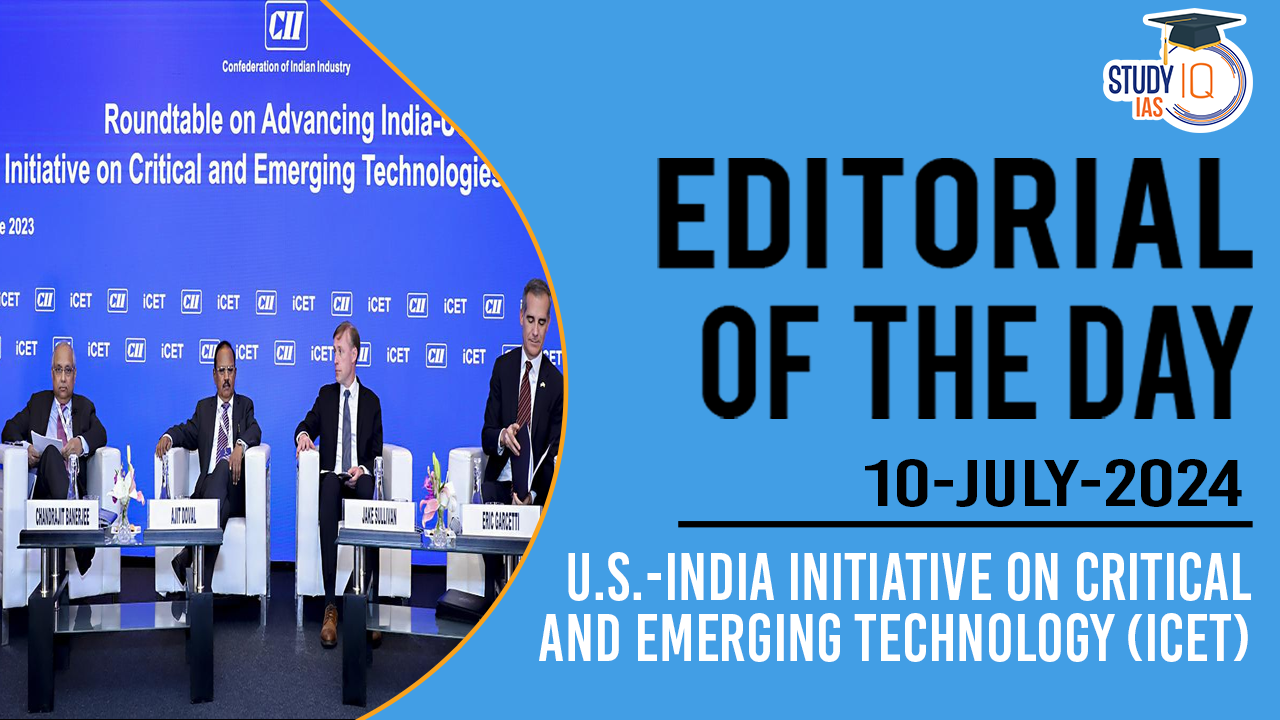Table of Contents
Context: Recently, India and the U.S. held talks to progress the iCET initiative.
About initiative on Critical and Emerging Technology (iCET)
- The India-U.S. Initiative on Critical and Emerging Technologies (iCET) was launched in January 2023.
- It aims to develop an open, accessible, and secure technology ecosystem.
- Significance:
- Supply Chain Integration: Crucial for enhancing India’s role as a trusted partner in global supply chains and technology value chains.
- Focus on Disruptive Technologies: Addresses key disruptive domains essential to the next Industrial Revolution and future warfare.
- Market Expansion: Opens new markets for India’s deep technology players.
Key Areas of iCET
- Semiconductor Supply Chain: India and the U.S. have established joint task forces focused on identifying and mitigating vulnerabilities in the semiconductor supply chain.
- Example: Micron Technology, a U.S. company, announced a $1 billion investment to build a semiconductor assembly and testing plant in Gujarat, India.
- 5G/6G Technology: Both countries are working together on developing joint standards for 5G technology and conducting interoperability testing.
- The goal is to enable the deployment and adoption of open RAN (Radio Access Network) in India.
- Cooperation on human spaceflight: Both countries are deepening cooperation on human space flight.
- Example: Advanced training for Indian astronauts at NASA’s Johnson Space Center.
- Incentivizing commercial players from both nations to collaborate, especially in activities related to NASA’s Commercial Lunar Payload Services (CLPS) project.
- Example: Advanced training for Indian astronauts at NASA’s Johnson Space Center.
- Space Cooperation: India and the U.S. have collaborated on joint space missions,
- Example: NASA-ISRO Synthetic Aperture Radar (NISAR) mission aims to provide critical data for understanding climate change, natural disasters, and Earth’s ecosystem.
- Biotechnology: Joint initiatives in biotechnology focus on healthcare innovations and biosecurity.
- Example: Launch of “Bio-X” initiative to promote cooperation in biotechnology and enhance competitiveness of biotechnology industries.
- Defense Technology: India and the U.S. are co-developing defence equipment, such as drones and advanced fighter jet components.
Challenges in Implementing iCET
- Technology Transfer Issues: U.S. defence companies are hesitant to share critical knowledge because of the fear of losing their competitive edge and intellectual property.
- Example: Current agreements allow only partial technology transfers, like 80% for GE F-414INS6 engines and just 10-15% for MQ-9 Reaper/Predator-B drones.
- Essential technologies, such as the special techniques for making turbine discs, are not shared.
- Example: Current agreements allow only partial technology transfers, like 80% for GE F-414INS6 engines and just 10-15% for MQ-9 Reaper/Predator-B drones.
- Strict U.S. Export Control Laws: U.S. laws impose strict regulations on sharing military technologies, even in joint ventures, making technology transfer difficult.
- Commercial Motivations:S. defence companies prioritise their shareholders and often take a conservative approach to sharing technology.
- The drive to maximise profits can make these companies less willing to share advanced technologies.
- Bureaucratic and Structural Challenges: Complex and slow bureaucratic processes can delay or block the implementation of collaborative projects.
- Example: The failure of the 2012 Defence Technology and Trade Initiative (DTTI) due to similar issues suggests potential challenges for iCET.
- Limitations on Innovation (Jugaad): Acquisitions through the Foreign Military Sales (FMS) route are subject to the ‘Golden Sentry’ end-use monitoring program, restricting India’s ability to apply innovative solutions to U.S. platforms.
- The inability to modify U.S. equipment to suit local conditions limits operational flexibility and effectiveness.
- Geopolitical Considerations: U.S. policy encourages India to reduce its dependence on Russian arms, complicating India’s defence procurement strategies and its long-standing military relationship with Russia.
- Maintaining strategic autonomy while deepening defence ties with the U.S. is a challenge for India.
- Prolonged Negotiations: Excessive discussions and prolonged negotiations can hinder progress, as seen in Augustine’s Laws, where too much talk can lead to little action.
Way Forward
- Technology Transfer and Roadmaps: Initiate technology transfer with less sensitive technologies and progressively increase complexity.
- Establish clear milestones and roadmaps to ensure mutual understanding of expectations and deliverables.
- Diplomatic Engagement: Maintain continuous high-level dialogues to address export control and IPR protection concerns.
- Advocate for policy adjustments in U.S. export control laws to facilitate smoother technology transfers.
- Public-Private Partnerships: Promote joint ventures between Indian and U.S. defence companies to enhance collaboration.
- Provide incentives like tax benefits and relaxed regulatory norms for U.S. companies investing in India.
- Increase domestic R&D investments and enhance skill development programs.
- Utilising Frameworks and Programs: Leverage INDUS-X and IMPACT programs to foster deeper collaboration.
- Utilise ADDD (Advanced Domains Defense Dialogue) to address emerging challenges and explore new cooperation areas.
- Geopolitical and Strategic Balancing: Diversify defence imports to reduce dependency on any single country while maintaining strategic autonomy.
- Strengthen strategic alliances with other countries to create a balanced defence procurement strategy.


 Why India Needs Its Own Economic Model?
Why India Needs Its Own Economic Model?
 Challenges in India’s Airline Sector: ...
Challenges in India’s Airline Sector: ...
 Forest Conservation Act, 1980: Objective...
Forest Conservation Act, 1980: Objective...

























